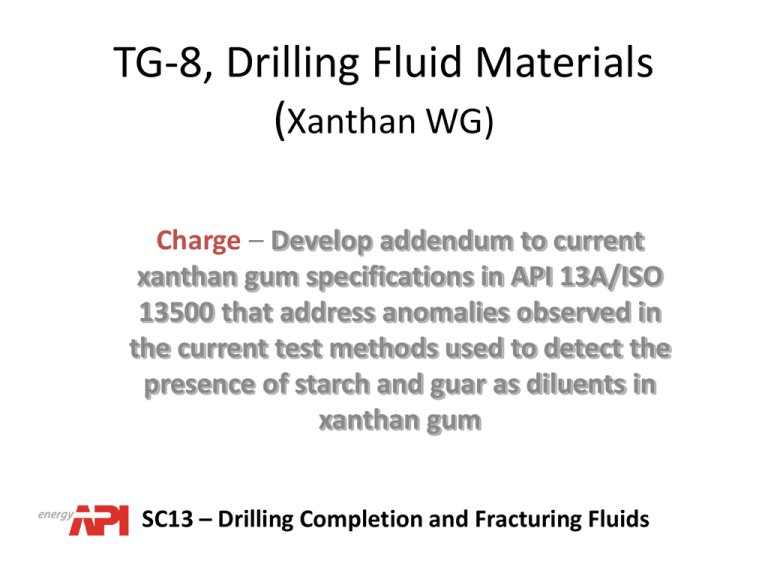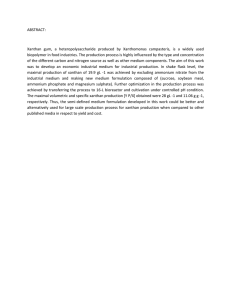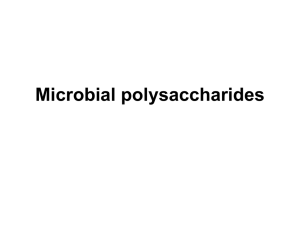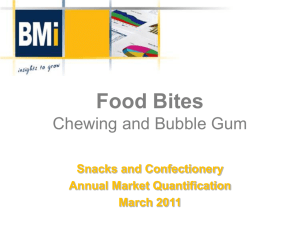TG08WG02 Winter meeting presentation rev Wilkin
advertisement

TG-8, Drilling Fluid Materials (Xanthan WG) Charge – Develop addendum to current xanthan gum specifications in API 13A/ISO 13500 that address anomalies observed in the current test methods used to detect the presence of starch and guar as diluents in xanthan gum SC13 – Drilling Completion and Fracturing Fluids TG-8, Drilling Fluid Materials (Xanthan WG) Members – Mac Seheult, Kelco Oil Field Group Tim Wilkin, MiSwaco Don Kraus, Baker Hughes Drilling Fluids Shannon Sobkowiak, Baroid Halliburton Luis Del Valle, Cargill Mike Azizi, WEGO/Fufeng Don Lindblad, Jungbunzlauer Carl Stouffer, Drilling Specialties David Breeden, Newpark SC13 – Drilling Completion and Fracturing Fluids TG-8, Drilling Fluid Materials (Xanthan WG) Last Meeting – Teleconference on 12/9/10 > Presented an overview of charge and opened floor for discussion of current position > Slides presented to re-visit impact of guar contamination and point at which presence of guar as a diluent was readily detectable using test method in 13A > Reviewed script for the starch contamination addendum as proposed by Tim Wilkin; all members in attendance agreed to proposal as written > It was concluded that a script similar in content to that of the starch addendum would be drafted by the Task Group Chair and forwarded for approval SC13 – Drilling Completion and Fracturing Fluids TG-8, Drilling Fluid Materials (Xanthan WG) (Xanthan Addendum Wording – Starch Test Anomaly) Referring to 19.2.6.2, 19.2.6.3, and 19.2.6.4, it has been determined by consultation with xanthan gum manufacturers that different carbon sources may be used in the manufacture of xanthan gum, including but not limited to dextrose, glucose, fructose, unmodified dent corn starch, unmodified waxy corn starch, unmodified tapioca starch, and unmodified potato starch. Other starch sources are also used, but may be less common. Some of the above referenced carbon sources may result in the color changes listed in these clauses without the xanthan gum tested having been intentionally adulterated with starch type carbon sources. The manufacturing process for xanthan gum, if not carried to completion may result in a product that contains residual unreacted starch or starch derivatives that may result in a color change by this procedure. SC13 – Drilling Completion and Fracturing Fluids TG-8, Drilling Fluid Materials (Xanthan WG) (Xanthan Addendum Wording) Conversely, some carbon sources for example maltodextrins may not result in color changes when tested by the procedure listed in the clauses referenced above. The user and manufacturer should discuss the starting raw material source for xanthan manufacture to determine if color changes in this test might be influenced by the manufacturing process. It may be useful for the user and manufacturer to test xanthan gum production to determine the influence of carbon source and its concentration in the finished product on color changes observed in this series of clauses. An example of a test useful in determining the potential influence of a carbon source on this test procedure would be development of a concentration curve of carbon source versus color intensity generated by the procedure in clause 19.2.5. A dark blue-black coloration would indicate a xanthan intentionally adulterated with starch. SC13 – Drilling Completion and Fracturing Fluids TG-8, Drilling Fluid Materials (Xanthan WG) (Xanthan Addendum Wording) Refer to Clause 19.1.1 for advice on intended product composition. The material described in this Section is intended to be solely xanthan gum with no adulterants added. SC13 – Drilling Completion and Fracturing Fluids TG-8, Drilling Fluid Materials (Xanthan WG) (Xanthan Addendum Wording) Guar Detection Test Anomaly Adulteration of Xanthan Gum with Guar Gum or Guar Derivatives Referring to 19.3.7 and 19.3.8, it has been determined by consultation with xanthan gum manufacturers that small increases in viscosity observed in the test described in these sections cannot be attributed to adultration of xanthan gum with guar gum or guar derivatives CMG, CMHPG and HP G, etc.), but may be an artifact of the testing regimen. Small increases in viscosity do not necessarily mean that the xanthan gum in question has been adulterated. It may be useful for the user and manufacturer to test xanthan gum production to determine the influence of guar gum additions on xanthan gum viscosity. An example of a test useful in determining the potential influence of adulteration on this test procedure would be development of data generated by the procedure in clause 19.3.7 with increasing amounts of guar gum added to a xanthan gum solution. Large increases in viscosity are indicative of adulteration. • Refer to Clause 19.1.1 for advice on intended product composition. The material described in this Section is intended to be solely xanthan gum with no adulterants added. SC13 – Drilling Completion and Fracturing Fluids








